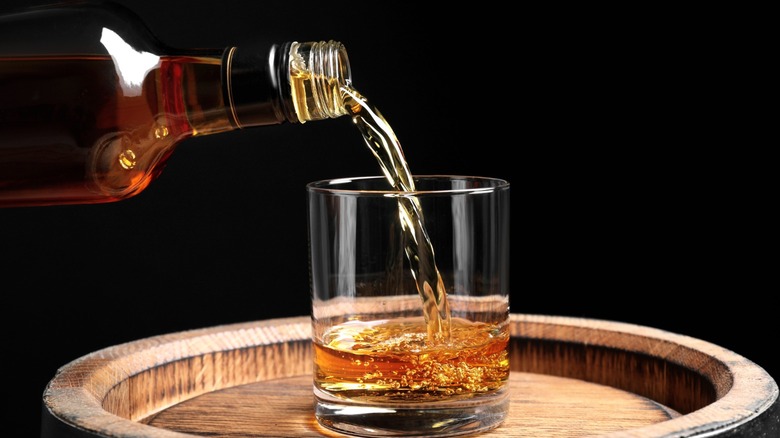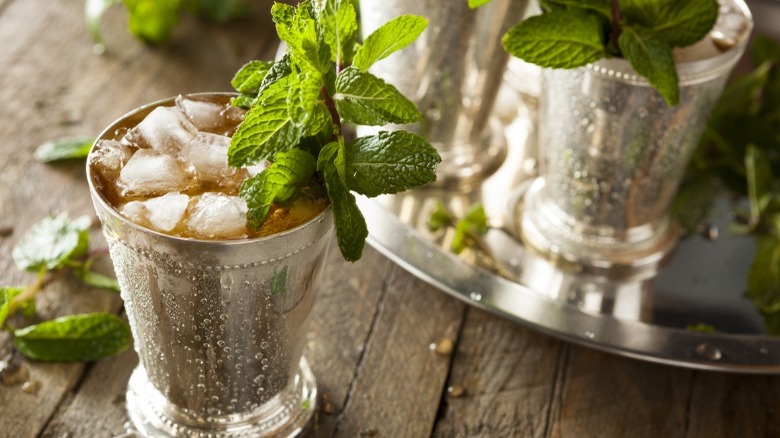During Prohibition, You Could Get A Prescription For Liquor
Food and drink as forms of medicine are not novel concepts — you've probably been told to sip on a steaming hot cup of chicken noodle soup or a mug of tea when you're sick. Alcohol, more specifically, has been regarded as having medicinal qualities since ancient times. However, what you may not have heard before is that during Prohibition, you could actually get a prescription for booze.
Yes, you read that right. During the 13-year-long ban on alcohol that began in 1920, the United States Treasury Department authorized doctors to write their patients a prescription for medicinal alcohol — typically distilled liquors like whiskey or brandy (which you can use to make brandied cherries for your bar cart). Prescriptions had to be written on special forms watermarked by the Internal Revenue Service, tasked with enforcing prohibition rules. The liquor was prescribed for illnesses ranging in severity from simple indigestion to cancer. A whole pint would set you back about $7 (the equivalent of around $109 in 2024) — $3 for the prescription itself, and up to $4 to have it filled.
Alcohol as medicine isn't a novel concept
When discussing alcohol as a medicine, the earliest references date back to ancient Chinese and Egyptian societies, who used wine to better administer herbal remedies, or it was often recommended for anxiety. In classical Greece, the famous philosopher Hippocrates thought wine was a good remedy for a number of conditions, and many Greeks used wine for both pathology and treatment purposes.
During the eighth and ninth centuries in Poland and Russia, respectively, vodka made with fruit, spices, and herbs was considered to have medicinal applications. In the 13th century, English philosopher Roger Bacon wrote about the medicinal properties of wine, describing how it supposedly preserved the stomach, aided digestion, and had defensive properties. In the United States, the mint julep is one early application of liquor as a medicine. A mixture of whiskey and mint, the drink was used as a kind of cure-all or tonic in the 18th century.
Despite 19th-century temperance movements that were vehemently against alcohol consumption, the medical community was largely divided on whether or not alcohol should be used on patients even into the early 20th century. Instead of having a legitimate medical application, the Prohibition-era whiskey prescription was likely a sneaky way to get around the ban.
What's the status of medicinal alcohol today?
You've likely never visited a doctor's office and been prescribed a bottle of whiskey for your runny nose, and that's because science and regulations have evolved beyond the days of medicinal booze. The World Health Organization reports that alcohol has been proven to be a contributing factor in more than 200 diseases, and its consumption is linked to mental disorders, liver disease, and even breast or colorectal cancers. Additionally, alcohol accounts for approximately 13.5% of deaths among adults between the ages of 20 and 39.
Despite this, there is evidence that some levels of alcohol consumption could provide health benefits, regardless of the type you're consuming. Studies show that moderate drinking may be good for your heart, and might even prevent gallstones. However, the issue with these studies is that there are varying definitions of "moderate," ranging from one drink per day to four, and what constitutes moderate drinking also varies based on other factors, such as gender. Potential benefits aside, the consensus among researchers is that the health risks associated with drinking alcohol increase the more you drink.
Additionally, there are now regulations for using alcohol in pharmaceutical settings. According to the Food and Drug Administration, over-the-counter products intended for those over the age of 12 cannot contain more than 10% alcohol. This percentage decreases to 5% for products meant for children between six and 12, and to 0.5% for children under six.



